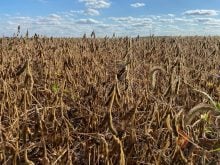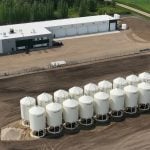Milk permeate could be an option to feed to transition dairy cows, but the logistics of moving or processing it on a farm will make its adoption a challenge.
Physiological and metabolic changes in cows as they approach calving and in the few weeks after are significant and feeding appropriate nutrition to cows is difficult as they are often in negative energy balance.
Enter a way to get more energy to transition cows while dealing with excess milk permeate in the marketplace.
Why it matters: When milk is processed into dairy foods like butter and cheese, there’s an energy-rich permeate left and there’s not enough market for it, which means some of it goes to waste.
Read Also

Partnerships, communication key to disease management
Communication and strong, trusted partnerships are key to managing infectious diseases like Foot and Mouth Disease and HPAI.
Renée Petri, a research scientist at Agriculture and Agri-Food Canada’s Sherbrooke, QC research and development centre led a research project that looked at the feed value of milk permeate in dairy rations.
“We are working with a byproduct that’s very expensive to dry because it is more than 90 per cent water, and very expensive to ship in its water form,” she said during a research symposium hosted by AAFC Sherbrooke.
Canada lacks the infrastructure to dry all the milk permeate it produces.
Permeate is rich in lactose, so high in sugars and also has some minerals, all things a fresh cow can use. Like giving an athlete a Gatorade after a competition, the sugars and minerals help the cow during a high-stress period.
Petri says research has been conducted in Western Canada on using dried permeate to supplement cows which showed that it provided energy while not reducing rumen acidity, so acidosis wasn’t caused by feeding the permeate.
She and her research collaborators wanted to know if feeding liquid permeate would have the same effect.
The long-term win of this approach would be to separate unneeded permeate on the farm, feeding it to the cows and then shipping the rest of the valued milk constituents to a processing plant in a much more concentrated form. That means less water would have to be transported, making moving milk more efficient, and decreasing transportation costs and environmental impact.
The work that had to be done at the research centre underlies the increased equipment and changes in production practices required to feed liquid permeate.
“We had to set up a whole new installation in our dairy barn looking at the production, the holding and storage of a liquid form of nutrition and develop a system to deliver it to each animal in the experiment,” she said.
For experimentation purposes, Petri used dried permeate that was returned to a liquid form using a DeLaval colostrum machine for mixing and then onto a holding tank, so the cows always had it available on demand. The cows accessed the permeate individually as they wished in a water bowl.
A functional challenge of storing a sugary liquid is to keep bacterial growth in check. The researchers found that after about 12 hours the microbial contamination was too high, so regular cleaning was required and would be a barrier to on-farm use.
Despite the logistical challenges of managing permeate on a farm, the product performed well as a feed for transition cows.
Cows voluntarily consumed it at a greater level than water, including during the calving period, when feed consumption usually drops.
Petri says the permeate is metabolized differently than other energy sources, with higher beta hydroxybutyrate (BHB) levels in the permeate group.
Cows fed permeate produced more milk once they were into their lactation.
“The maintenance of the milk production shows that we have a positive effect on the bottom line for the producer when we’re supplementing energy in a liquid form,” she said.
There were other effects, including more stable pH and significantly lower ammonia nitrogen in the rumen.
There remain numerous questions about how such a system could work on a farm, but Petri is talking with the industry about how the system could work without increasing microbial load and needed sterilization.













